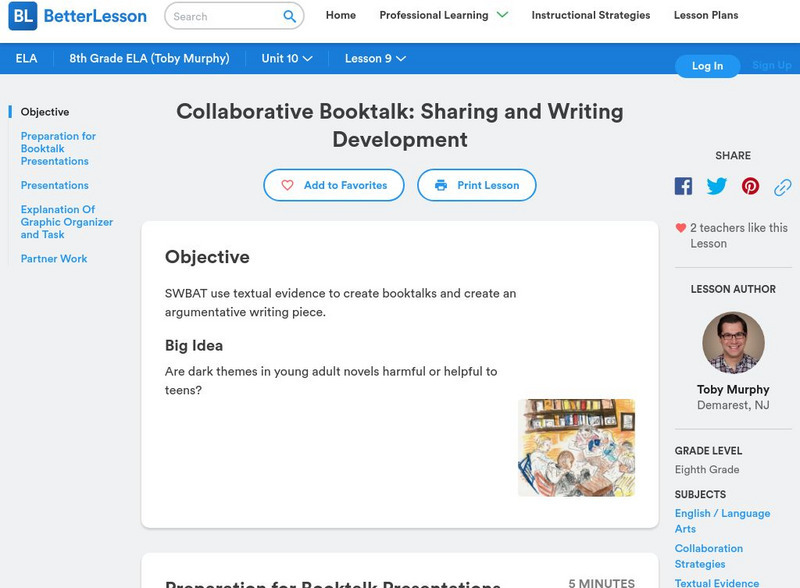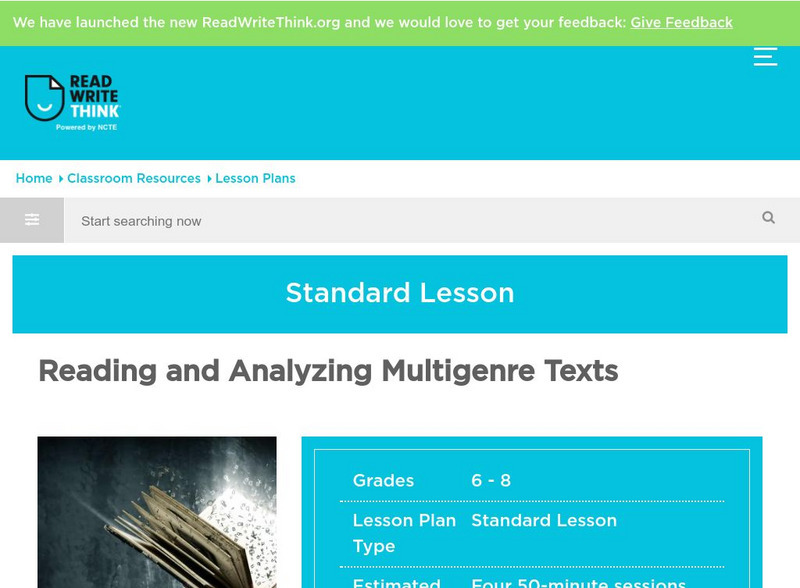Better Lesson
Better Lesson: Collaborative Booktalk: Sharing and Writing Development
Are dark themes in young adult novels harmful or helpful to teens? Students will explore this question and will create an argumentative writing piece based on textual evidence. Videos of the lesson in action, examples of student work,...
Other
Curriculum Associates: Comparing and Contrasting Texts [Pdf]
In these activities, students are asked to compare and contrast two versions of each event with two pieces of writing that are about the same topic. Teaching notes with answer keys are provided as well.
CPALMS
Cpalms: Structures and Skeletons
In this interactive learning module, students read informational text about dinosaurs and examine paragraph structure. They will learn about different types of text structure for informational paragraphs, identify the most effective...
PBS
Pbs Learning Media: Elements of Poetry
Discover how literary techniques like figurative language, imagery, and symbolism contribute to the overall meaning of a poem. Explore how a poet establishes and builds on a theme and the difference between tone and mood. Through a close...
Library of Congress
Loc: Poetry 180: How to Listen
In this non-prose piece, the poet shares how to listen carefully to others.
AdLit
Ad lit.org: Classroom Strategies: Power Notes
Power Notes is a strategy that teaches students an efficient form of organizing information from assigned text. This technique provides students a systematic way to look for relationships within material they are reading. Power Notes...
AdLit
Ad lit.org: Extended Discussion of Text Meaning and Interpretation
Teachers should provide opportunities for students to engage in high-quality discussions of the meaning and interpretation of texts in various content areas as one important way to improve their reading comprehension.
Ted Nellen
Cyber English (By Ted Nellen): Rhythm and Rhyme
This is a glossary entry for the terms "Rhythm" and Rhyme" including the definition of each and literary examples of each.
Vocabulary.com
Some Helpful Poetry Terms
This site contains a list of 24 poetry terms. Teachers can digitally assign this list to their students to reinforce the spellings, pronunciations, and meanings of these words
E Reading Worksheets
E Reading Worksheets: Patterns of Organization: Compare and Contrast
This learning module provides an explanation of the compare and contrast text structure. An explanation of the compare and contrast text structure is provided, and the compare and contrast text structure is demonstrated in a video...
Curated OER
Mc Graw Hill: Use Details and Examples
Review how to use text evidence, details, examples, and personal experiences to make inferences then read a passage to practice on your own.
Curated OER
Mc Graw Hill: Part 2 Reading: Determine Main Ideas and Supporting Details
See an example of how to determine the main ideas and supporting details of a story.
E Reading Worksheets
E Reading Worksheets: Patterns of Organization: Order of Importance
This site provides an explanation of the order of importance text structure. A diagram is provided to provide to supplement the explanation.
Other
Text Help: Middle Grades Informational Text [Pdf]
A useful resource with ideas for teachers to meet the Common Core Standard 8.3 for informational text. The ideas are designed for use with the program Read and Write Gold, but could be implemented on paper.
Other
Owl Editing: Understanding the Meaning of Poetry
This OWL Editing page provides a chart that breaks down the factors to analyze when trying to understand poetry's deep meanings.
Other
Interacting Texts Directed Activities Related to Texts (Darts)
Want to improve your students' reading skills? This is a good place to find the types of directed activities, using a definition text, reconstruction/analysis activities, and advantages of using DARTs.
ReadWriteThink
Read Write Think: World Poetry Day Activity
A classroom activity/lesson plan which marks World Poetry Day. Allows students to discuss, appreciate, and respond to different types of poetry, and includes web links and an annotated bibliography. From March 21, 2007.
ReadWriteThink
Read Write Think: Poetic Form and Structure
This online lesson makes use of concrete poems to teach the structure and form of poetry. Uses a "Columbus Day," theme for the lesson, but can be used any time of the year.
ReadWriteThink
Read Write Think: Reading and Analyzing Multigenre Texts
This lesson plan deals with the process of analyzing a variety of literary texts from poetry and letters to diary entries and works of fiction. Included in the lesson plan is an overview, practice, objectives, resources, preparation, and...
Houghton Mifflin Harcourt
Holt, Rinehart and Winston: Elements of Literature: Poetry You've Got Rhythm [Pdf]
A short but informational worksheet for students on the rhythmical sounds of poetry. Includes information about the different types of meter and feet, and allows students to make connections and analysis.
Curated OER
Mc Graw Hill: Part 2 Reading: Informational Text: Compare Text Structures
Compare the text structures in two nonfiction passages in this tutorial.
E Reading Worksheets
E Reading Worksheets: Patterns of Organization
This site discusses the topic of patterns of organization of paragraphs. Links with video content and further explanations about the following patterns of organization topics are provided: sequence, spatial, cause and effect; order of...
Capital Community College Foundation
Guide to Grammar and Writing: Developing a Definition
Not sure what a definition paper is? This is a great site from the Capital Community College to help you with developing a definition. Includes a sample essay and guiding questions.
TES Global
Blendspace: Cause and Effect
This eleven-part Blendspace is designed to be used while teaching students how to analyze cause and effect. Links include reference sheets, a SMART Notebook Lesson, posters, practice worksheets, and guided practice opportunities.



![Curriculum Associates: Comparing and Contrasting Texts [Pdf] Lesson Plan Curriculum Associates: Comparing and Contrasting Texts [Pdf] Lesson Plan](https://d15y2dacu3jp90.cloudfront.net/images/attachment_defaults/resource/large/FPO-knovation.png)







![Holt, Rinehart and Winston: Elements of Literature: Poetry You've Got Rhythm [Pdf] Unit Plan Holt, Rinehart and Winston: Elements of Literature: Poetry You've Got Rhythm [Pdf] Unit Plan](http://content.lessonplanet.com/resources/thumbnails/410060/large/bwluav9tywdpy2symdiwmduymc03otczlw41bjdpdy5qcgc.jpg?1589985147)

